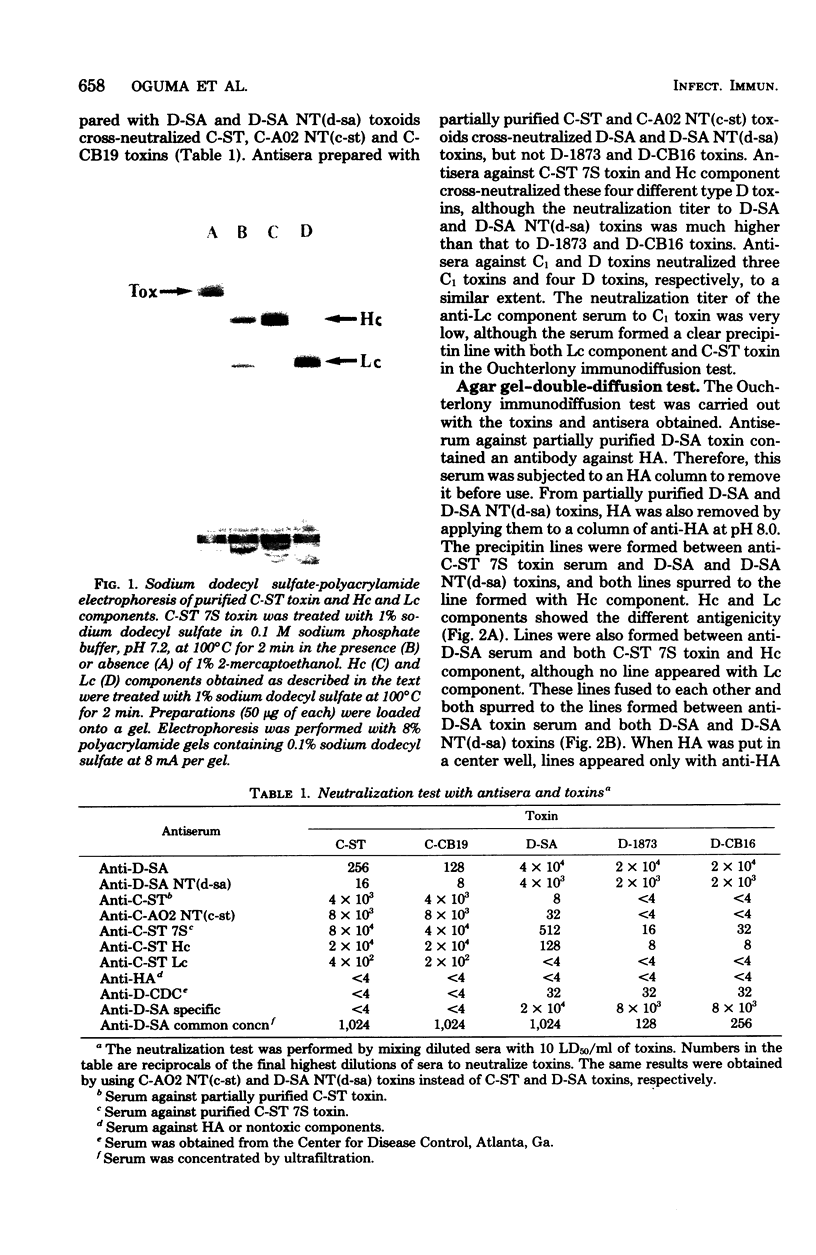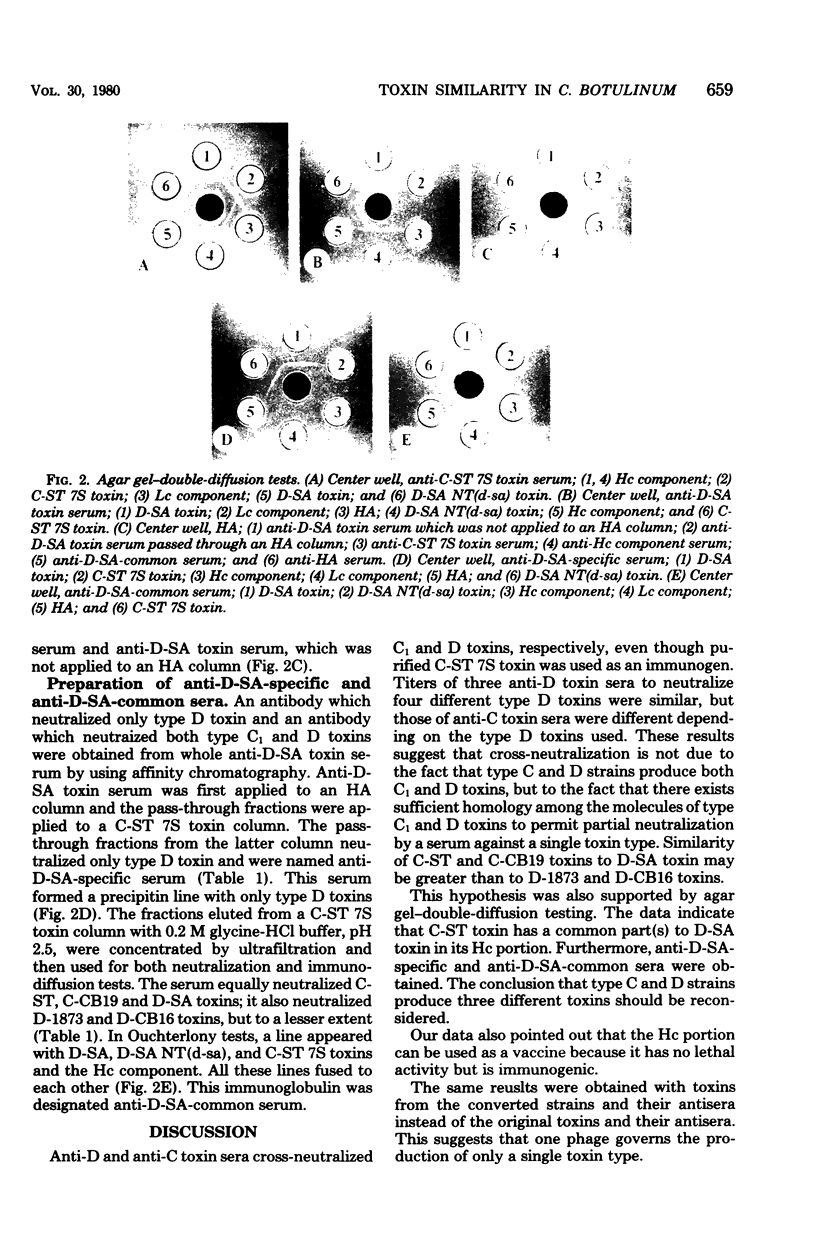Abstract
Antisera against purified type C1 toxin of Clostridium botulinum and its heavy-chain component cross-neutralized type D toxin. Antisera against partially purified type D toxin cross-neutralized type C1 toxin. From the latter serum, a component which neutralized only type D toxin and a component which equally neutralized both C1 and D toxins were obtained. We concluded that the cross-neutralization was not due to the fact that type C and D strains produce both C1 and D toxins but rather to the fact that the toxins have an antigen(s) common to their molecules. The results of the agar gel-double-diffusion test also supported this conclusion.
Full text
PDF




Images in this article
Selected References
These references are in PubMed. This may not be the complete list of references from this article.
- Eklund M. W., Poysky F. T. Activation of a toxic component of Clostridium botulinum types C and D by trypsin. Appl Microbiol. 1972 Jul;24(1):108–113. doi: 10.1128/am.24.1.108-113.1972. [DOI] [PMC free article] [PubMed] [Google Scholar]
- Eklund M. W., Poysky F. T., Reed S. M. Bacteriophage and the toxigenicity of Clostridium botulinum type D. Nat New Biol. 1972 Jan 5;235(53):16–17. doi: 10.1038/newbio235016a0. [DOI] [PubMed] [Google Scholar]
- Inoue K., Iida H. Phage-conversion of toxigenicity in Clostridium botulinum types C and D. Jpn J Med Sci Biol. 1971 Feb;24(1):53–56. [PubMed] [Google Scholar]
- Jansen B. C. The toxic antigenic factors produced by Clostridium botulinum types C and D. Onderstepoort J Vet Res. 1971 Jun;38(2):93–98. [PubMed] [Google Scholar]
- Kozaki S., Sugii S., Oishi I., Sakaguchi S., Sakaguchi G. Proceedings: Clostridium botulinum type A, B, E and F 12S toxins. Jpn J Med Sci Biol. 1975 Feb;28(1):70–72. [PubMed] [Google Scholar]
- Miyazaki S., Iwasaki M., Sakaguchi G. Clostridium botulinum type D toxin: purification, molecular structure, and some immunological properties. Infect Immun. 1977 Aug;17(2):395–401. doi: 10.1128/iai.17.2.395-401.1977. [DOI] [PMC free article] [PubMed] [Google Scholar]
- Oguma K., Iida H., Shiozaki M., Inoue K. Antigenicity of converting phages obtained from Clostridium botulinum types C and D. Infect Immun. 1976 Mar;13(3):855–860. doi: 10.1128/iai.13.3.855-860.1976. [DOI] [PMC free article] [PubMed] [Google Scholar]
- Oguma K., Iida H., Shiozaki M. Phage conversion to hemagglutinin production in Clostridium botulinum types C and D. Infect Immun. 1976 Sep;14(3):597–602. doi: 10.1128/iai.14.3.597-602.1976. [DOI] [PMC free article] [PubMed] [Google Scholar]
- Oguma K., Nakane A., Iida H. Observations on toxin and hemagglutinin produced by Clostridium botulinum type C. Appl Environ Microbiol. 1978 Feb;35(2):462–464. doi: 10.1128/aem.35.2.462-464.1978. [DOI] [PMC free article] [PubMed] [Google Scholar]
- STERNE M. Hemagglutination by Clostridium botulinum type D. Science. 1954 Apr 2;119(3092):440–441. doi: 10.1126/science.119.3092.440. [DOI] [PubMed] [Google Scholar]
- Syuto B., Kubo S. Isolation and molecular size of Clostridium botulinum type C toxin. Appl Environ Microbiol. 1977 Feb;33(2):400–405. doi: 10.1128/aem.33.2.400-405.1977. [DOI] [PMC free article] [PubMed] [Google Scholar]
- Weber K., Pringle J. R., Osborn M. Measurement of molecular weights by electrophoresis on SDS-acrylamide gel. Methods Enzymol. 1972;26:3–27. doi: 10.1016/s0076-6879(72)26003-7. [DOI] [PubMed] [Google Scholar]




